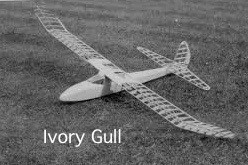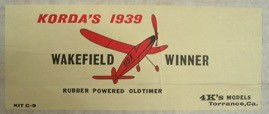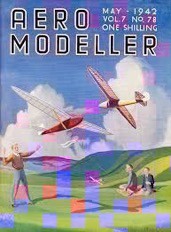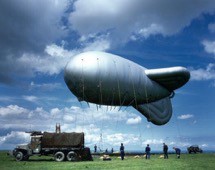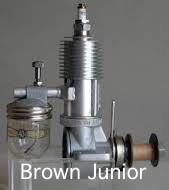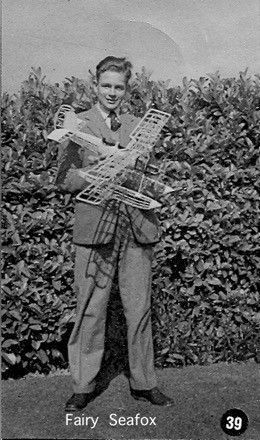|
Christchurch and District Model Flying Club |
|
BEFORE I FORGET BY KEN SPOKES Part 2, continued from the July 2018 Sloping Off |
|
Most of the things I made were from scraps of wood which I scrounged from local building sites after the joiners had finished work for the day. Boats were a favourite for sailing on nearby ponds and streams and also accessories for my model railway. I don't remember making wooden aeroplanes. Looking back I suppose at that time I had not really been aware that model aeroplanes existed that could actually fly. I think probably being given a Frog Interceptor kindled some interest in flying models. I imagine that the Frog kit must have been one of the earliest ARTFs ever produced. It was rubber powered, had a wing span of about 15 inches and came in a box with a built-in winder for the rubber motor. (I never had one of these, but was very jealous of Tony Smith over the road who did have one, even though he was not really interested in flying it! - Ed) From what I can recall, it didn't fly very well or last very long no doubt due to my inexperience. Penny catapult gliders could be bought from most toy shops. They had a wingspan of about twelve inches and were made of balsa wood. We used to have contests to see who could make them glide the farthest. These never lasted very long either. We flew home- made kites which were fun to make but never performed as well as shop bought Box Kites which were popular at the time. I enjoyed reading which was mostly from magazines such as the Meccano Magazine, Practical Mechanics. Modern Wonder and pulp comics like the Adventure, the Wizard, Hotspur and the Champion which were passed around by all the boys in the neighborhood
My first aviation memory of any note was standing in the garden with my parents to watch the R100 airship drone majestically overhead I remember it flew very slowly and remained in view for quite some time. I have since learned that it was on a proving flight over the Midlands prior to a tour of Canada
.In the early thirties, aeroplanes were very rarely seen so it caused some excitement when Alan Chobam’s flying Circus visited Crewe. They used a large field on the outskirts of town which was soon destined to become the site of the Rolls Royce factory makingMerlin engines during the war and later, cars. Regrettably, I was not taken to watch the flying display but remember seeing a formation of five or six assorted aeroplanes as they flew around the area to advertise the show.
The thirties was an era when aviation was regularly making headline news and the likes of Amy Johnson, Jim Mollison, Scott and Black and Bert Hinkler were household names making record flights all over the world.. I remember hearing on the radio that Amy Johnson had finally landed in Australia after her epic solo flight. It seemed aviators were all competing to see how they could fly furthest,fastest. Each year, aviation was celebrated by Empire Air Day - we had an empire in those days - when RAF stations up and down the country opened their gates to the public and put on flying displays. Our nearest station was Tern Hill and to my delight, was taken there by my Dad in 1939. My most vivid memories of that day included seeing a row of silver biplanes which were probably Hawker Demons or Furies and being taken to look into the cockpit. That was the first time I had ever seen an aeroplane on the ground and during the day, I must have seen many aircraft that were currently in service immediately pre-war. There were thrilling aerobatic displays including a performance by Amy Johnson in a glider and “set piece” bombing raids with lots of bangs and flashes and of course, an amazing crazy flying display by an “inebriated” pilot. The highlight of the day was a Spitfire flying from Scotland to the South passing over a number of airfields on the way. The loudspeakers extolled the event as we all awaited agog to see the latest wonder fighter which suddenly appeared, flashed overhead and in the twinkling of an eye, was gone. On the way home in the coach, I was sick! A very memorable day! As I mentioned, aeroplanes were rarely seen so it was surprising one day to see a procession of small planes flying overhead at intervals, all heading in the same direction It turned out that it was the Kings Cup air race and was probably the occasion when they were on their way from London to the Isle of Man. When I was nine or ten years old, we moved a short distance to another house. An older boy lived next door whose hobby was building radio sets. Spending time with him, I soon became familiar with resistors, capacitors, coils and valves and how they could all be assembled to receive radio signals. I had little idea of how it all worked, but by following construction plans in F.J Camm’s magazine, Practical Wireless and with the help of my friend, I made a number of receivers ranging from a simple crystal set to those with valves.
I had little interest in the broadcasts and as soon as a set was working, I would take it all apart and reuse the components to build something better. Eventually, I lost interest, but it had been a good experience which taught me how to solder, make simple meter readings and use a variety of hand tools. I heard later that my friend joined the Merchant Navy as a radio operator but was sadly lost at sea during the war. About this time, I visited a friend's house and was shown the framework of a small balsa model aeroplane that his Dad was building It was almost ready for covering and having never seen anything like it before, thought it was quite amazing. I really was impressed and when I found that kits could be bought for a few shillings and made into flying models, I was soon the proud owner of one called Nimbus This was a small rubber powered model with a wingspan of about 24 inches.. It came in a box with a picture of the finished model on the front and contained a plan, 3/32 square balsa strips and a few sheets of 1/16 balsa on which were printed wing ribs and other parts. There was also a part prepared balsa propeller which required carving into shape, a nose block, some tissue and a length of rubber strip. Balsa cement, tissue paste, dope and rubber lubricant had to be bought separately. Its construction was all new to me but I managed to finish it despite cut and cement encrusted fingers. There were no scalpels then and an open razor blade snapped at an angle was the only really sharp cutting tool available.. Surprisingly, it flew quite well although flight times rarely lasted more than half a minute. All my modelling took place in my bedroom with the large sill of a bay window doubling as my building board. The walls were covered from floor to ceiling with clippings of aeroplane pictures. Fortunately, my parents were very tolerant of the smell of dope and the bits of balsa wood that found their way all over the house. There was no club to join for help and advice so building and flying was very much trial and error. The learning curve, however, was quite steep and I was soon familiar with angles of incidence, down-thrust, CG, etc, and the effect these all seem to have on flight performance
The rubber motor was stretch-wound using a hand drill and I quickly learned the hard way not to add those few extra turns and then when it snapped, watch the sides of a model ripped to pieces by a writhing "live thing" Rubber motors were “double wound” to prevent sagging or bunching at the end of a run and were lubricated with anything slippery that I could find such as glycerine and soft soap. Jap (Japanese) tissue was the universal covering material and was applied to the model frame with special “Tissue Paste” bought in a small tube. However, this was soon replaced by ordinary paper paste which was cheaper and seemed to do the job just as well. After fixing in place, it was first dampened to tighten and when dry, given a coat of Banana Oil and finally Dope. Although this routine was religiously followed I have often wondered - what was the purpose of the Banana Oil.? Later, this stage was dropped with no apparent adverse effect. Embellishments were sometimes made with waterslide transfers. Gluing was exclusively with Balsa cement bought in small tubes.It was regularly suggested in the model magazines that for strong joints, the practice of “double-gluing”was adopted. This involved smearing glue on both parts and when dry making the joint in the usual way. In my impatience to finish a model, this good advice was rarely followed. I quickly learned the merit of the sanding block and how important sanding was to the final finish. My early models were built exclusively from kits which were mostly British made. Some small scale rubber powered American kits were bought but while they were fun to build, they never flew well- if at all .Unlike the British kits which were “dry” they included a small glass phial of balsa cement which was totally useless since it was not enough to complete the model and soon after it was uncorked, quickly dried up. After a while, I found that it was much cheaper and satisfying to build from plans or blueprints as they were called and even better, to design my own.
Perhaps design is an overstatement, as I noted the arrangement and key features of a proven model and then drew my own plans for a shape and to a scale for whatever took my fancy. Wing ribs were always flat bottomed for easy building. Fuselages were always slab-sided. Single blade (recycled broken props) ,freewheeling and folding props were sometimes fitted to try and improve performance . Gliders were also built from plans published in the Aeromodeller. These were quite small with wingspans rarely over three feet. Mr Gosling’s Ivory Gull was one I remember building, another (Pictured) was a Mick Farthing “Lightweight”.This model was unusual in that the fuselage was a square cross section streamline shape but rotated through ninety degrees in the model. They were usually launched by attaching a length of string and towing into wind or by a simple bungee made from several yards of motor elastic. The very flimsy nature of the models meant that flying could only be enjoyed when there was a flat calm or very light breeze, usually early morning or evening. As there were no weather forecasts - at least as far as I was aware – my “fly, no-fly indicator” was simply watching how much the leaves fluttered on the top of a nearby poplar tree. I was fortunate that several large flying fields were only minutes away - all long since built over by housing developments. The highlight of the modelling year was the Wakefield Cup competition for free flight endurance of rubber powered models. This was open to modellers world wide and the winning model was quickly kitted and on sale. The winner in 1939 was Dick Korda, an American and a copy of his model was without doubt, the best and largest rubber powered model I ever built.
Microfilm models were popular for a while and I built several but soon gave up as they were very fragile and so easily damaged that it didn't seem worth the effort involved. Also, I got into trouble for not cleaning the bath after I had used it to make the microfilm by pouring a mixture of dope and castor oil on the surface of the water. Most of my pocket money was spent on l materials and of course, the Aeromodeller priced sixpence ( 2 1/2p) which had just started publication. I missed the first few issues, but from about No 6 onwards every copy was saved until the time when RCM&E was first published when I sold them to buy a camera.
Aeromodelling materials were relatively simple, mostly 1/32" and 1/16" sheet balsa and 3/32" and 1/8"square balsa strips, Jap tissue, 18g piano wire, tubes of balsa cement, dope and lengths of ¼” flat rubber strip. Accessories, such as a brass bush for the prop shaft, and celluloid wheels were occasionally bought but usually these were recycled from deceased models. Such supplies were obtained from the front room of a private house which was really nothing more than a store room . We used to cycle there after school, knock on the door and wait. After about five minutes, the door opened and a man would stand there in his dressing gown and with bad grace sell us what we wanted which rarely amounted to more than a few pence. It turned out that he worked nights and was usually asleep when we knocked. I never understood why he thought it worthwhile. It wasn't until many years later that the local cycle shop stocked a decent range of model goods and even better, it was only a five minute cycle ride from home. Engine powered models were well beyond our means and capabilities at this time. Adverts for petrol engines such as Brown Junior, Gwyn-Aero, Ohlsson and Baby Cyclone regularly appeared in the Aeromodeller together with those for American “Gas Model” kits but were of only passing interest and envy. Adult modellers such as Bowden, Russell and Forster were well featured at this time for their large petrol-engined free flight models and were regarded as the elite of the hobby. I was thirteen when war was declared in 1939 when it was confidently expected that death and destruction would immediately rain down from above. To our relief, life went on more or less as normal for a year or so until the Blitz started Being a major railway junction, we fully expected Crewe to be targeted by the Luftwaffe but thankfully we were left alone apart from a few small raids by single aircraft.. We were however on the route of enemy bombers attacking Liverpool and Manchester and at the height of the Blitz spent many sleepless nights under the kitchen table as they passed overhead and were fired on by the local AA guns. Quite frightening as we never knew whether the loud explosions we heard were from the guns or bombs. The Radio stations would close down first and then the Air Raid Siren would sound and shortly afterwards the first raiders would be heard. German aircraft were easily recognized by the sound of their desynchronized engines which produced a distinctive beat. It would often be the early hours of the morning before the All-clear was sounded when thankfully we could go to bed, The town was protected by a number of barrage balloons which as far as I was aware, didn’t bring down any enemy planes but regrettably brought down several of our own.
In an effort to hide the town, Paraffin Smoke Generators were placed along many of the local roads but seemed to do little other than create a horrible oily smell and were quickly removed once the Blitz was over. It was only towards the end of the war that we were to hear the Air Raid Sirens again when a few Doodlebugs (V1) reached the Midlands having been launched over the North sea from adapted bombers. As the war progressed, the number of aeroplanes seen flying around increased dramatically, Most were training aircraft such as Ansons, Havards and Masters flying from local airfields that had sprung up like mushrooms. Regrettably, with such activity, there were many crashes which, ghoul like, we cycled to see and to scavenge for bits in the wreckage. Instruments and other choice pieces became playground currency. For many years, I had the landing light from a Wellington which was recycled later as a reflector for a photoflood. With the arrival of the Americans we began to see Mustangs ,Lightnings and Thunderbolts often engaging in mock dogfights. Occasionally, large numbers of Flying Fortresses and Liberators would fly over at high altitude leaving condensation trails which would sometimes expand and blanket the sky, turning a sunny day into a cloudy one. On the model front, materials began to get scarce not least, balsa wood which was soon to be replaced by substitutes such as Obechie which was heavier and tougher but still enabled us to make reasonable flying models. It was no surprise that Jap tissue and American kits and magazines disappeared completely. I was never aware that there was a shortage of rubber strip. Flying petrol engine powered planes was banned for the duration of the war but this didn't affect us as nobody I knew had ever seen one nor could even have afforded one.. Much later, I managed to get hold of an old Brown Junior engine that I must have swapped for something or other - it was like owning the Crown Jewels. It was drooled over, fondled, but was so worn out that it never ran.
Every so often a national savings week was promoted to raise funds for the war effort. These had themes such as “Salute the Sailor Week”, “War Weapons Week” and “Spitfire Week”. There would be parades through the town by the local Home Guard, Sea Cadets, Girls Training Corps, the ATC and other organisations. Shops would decorate their windows with patriotic displays and for Spitfire Week, I was asked to build a large model Spitfire ( non-flying) which graced Woolworth’s window .Another scale venture at the time, was a Fairy Seafox, which was fun to build, but was never intended to fly and was never fully completed.
Part three next time - Ken gets a job and joins the Air Cadet Corps |
|
[Home] [Chairman's Chatter] [Fun Fly] [Seaplanes at Poole] [Rosebowl] [Ken's] [BIMBO 2018] [Comox Spitfire] [Tailpiece] |
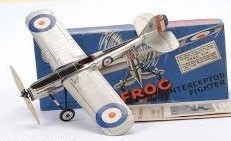
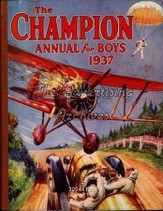
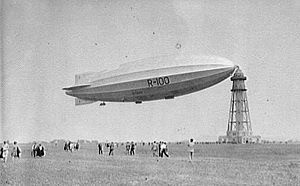
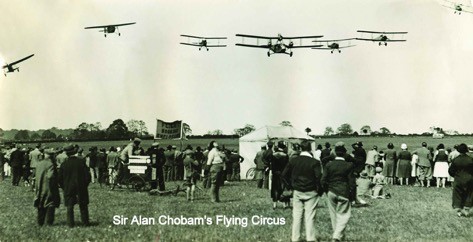
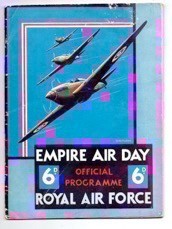
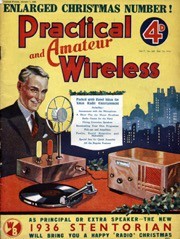
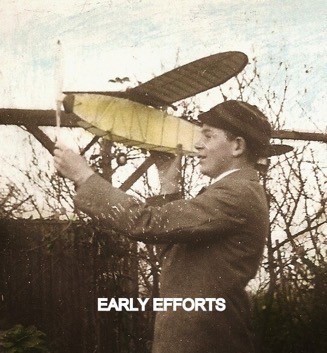
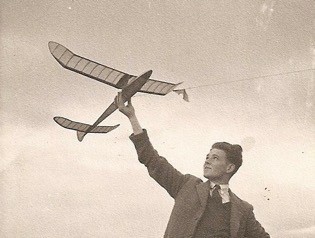 “Mick Farthing” Lightweight
“Mick Farthing” Lightweight